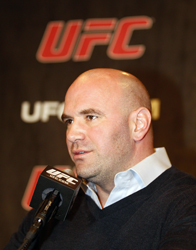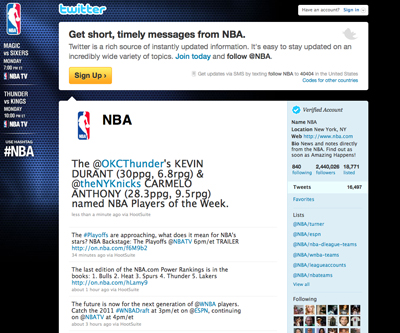The NFL is navigating through a unique offseason, to say the least.
Fans, players and constituents are discussing the lockout via social media channels. So, how does the NFL rank socially?
The NFL showed up late to the party. As a result, its reach and engagement levels are weak compared with other sports entities. We’re talking about a brand that has dominated traditional media for years. The NFL owns television. Historically, it has used TV to communicate to its fans in a one-way dialogue. Its success with this medium has been impressive, as its ratings and revenue show. The league has built its brand through the TV platform. However, there’s been a lot of talking and very limited listening to fans.
Combined, Facebook and Twitter have nearly 1 billion users who spend a great deal of time every day consuming information in these communication channels. The media landscape has changed; the largest international distribution networks that exist today are all online. All types of content are exchanged, from live video to photos and archived video.
Why is the NFL underperforming in the social media arena? The NFL didn’t focus on building its social influence until it was needed, similar to how LeBron James and Charlie Sheen turned to social media when they needed or wanted something. The innocence and genuine desire to connect with fans wasn’t there. It’s like trying to join a secret club without paying the dues. Fans understand intent. Facebook and Twitter were not invented for marketers, so it’s imperative to blend into the conversation versus shouting the messages in an old-school fashion, similar to what marketers have done for years on television.
If we take a look at other sports entities as a comparison, it’s easy to find the ones that have been successful with social media. The NBA and UFC are two of these organizations. Ninety-five percent of UFC athletes are on Twitter, and the organization provides ongoing social media training for its athletes. UFC President Dana White and co-owner Lorenzo Fertitta have personally embraced social media, as well. White has more than 1.3 million followers on Twitter and has maintained ongoing dialogue with his audience for the past two years.
“I respect our fans and personally keep them updated, even during unpopular situations,” White said. “I love the personal connection I have with the fans through social media. You have to be willing to listen and care about what the fans think about your product.”
The NBA also got in early and it has built major equity within social channels. More than two years ago, I worked for the Phoenix Suns as the director of digital media. I recall walking into one of our standing weekly revenue meetings with the team’s president, general manager and senior vice presidents and
| 
GETTY IMAGES
UFC President Dana White has more than 1.3 million followers on Twitter,
where he has engaged fans in dialogue for more than two years. The NBA
also is an early adopter of the social media strategy. |
announcing that I wanted to host a fan tweet-up. It was a way to grow the team’s social media presence, sell tickets and integrate a sponsor. At first I received responses like, “You want to plan a what-up?” We ended up hosting the first pro sports tweet-up and the team, as well as the league, embraced social media, giving both a head-start by a few years.
When the live sporting event ends, brands must have a way to communicate with their fan bases on their fans’ turf. Unlike traditional media, social channels provide a communication bridge that doesn’t have a shelf life. The fan dialogue never turns off.
There’s been a “land grab” situation that has been taking place over the past few years. The brands that built their influence within the world of social media are now seeing the return on their investment. When you combine a brand’s social reach, Facebook fans and Twitter followers with fan sentiment and engagement levels, you can identify how much influence that brand has within these new mediums.
Certain brands adopted the space and worked at building relationships every day. The NFL likely felt it didn’t need it. The path to monetization wasn’t exactly clear, but intuitively, brands like Starbucks, Barack Obama’s presidential campaign and The New York Times knew it was worth their investment.
Social media is extremely valuable from a research standpoint. Through features like Facebook Questions, polls can be conducted that allow brands to garner high-volume and instant feedback on fan sentiment. Research methods have changed. One of the fastest ways a brand can get an understanding about where its audience stands is through social media.
The athletes who have invested time in building their relationships with fans via these channels have an advantage. Arizona Cardinals wide receiver Larry Fitzgerald’s use of social media has allowed him to stay relevant with both fans and endorsement brands when he’s not on the field playing. Players who have neglected the space don’t have the advantage of connecting and communicating with fans during this critical time. Having a direct bridge to them when the game is over was never an option, until now. “Social media gives me a chance to really engage with my fans and share the things I’m passionate about outside of football,” he said.
Humans connect with humans, not logos. The humans behind the logos matter, and fans expect to hear from them. There’s a difference between transparency and truthfulness.
Sports business executives, especially those with personalities like Mark Cuban or UFC’s White, can demonstrate their commitment to communicate with their audience in a truthful manner. It’s not a popularity contest; it’s a communications channel. People may not always like what they have to say, but they’ve built a layer of credibility by personally getting involved and listening, not just talking. Clearly, social media has become fundamental in their business.
There are times when NFL Commissioner Roger Goodell disappears from Twitter for weeks and months. Is he listening on a daily basis? Is it really him behind that avatar? Brands can no longer hide behind their logo avatars.
At the end of the day, we’re all in business, but fans vote every day whether we stay in business.
Amy Martin (amy@thedigitalroyalty.com), founder of Digital Royalty, develops social media strategies for sports teams, leagues, athletes and corporate brands, including Dana White and UFC, to increase their online influence.






